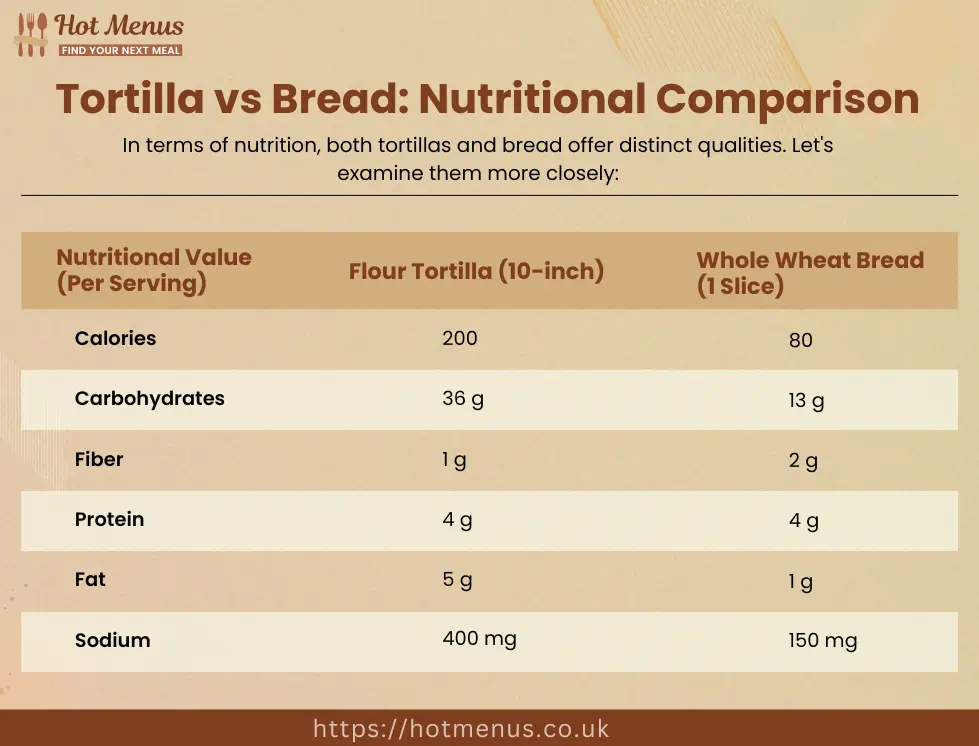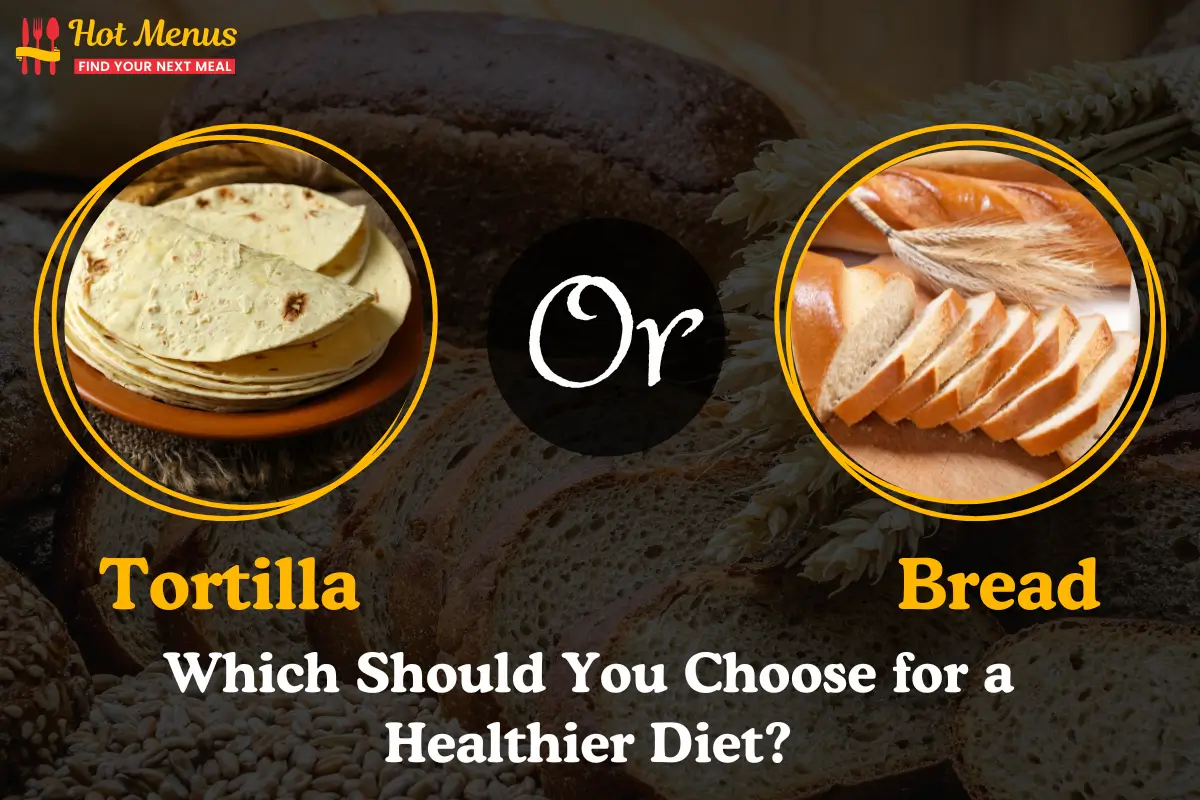When it comes to meal choices, tortillas and bread are both classic options found in many kitchens. They provide versatility for every meal, from sandwiches to wraps. Understanding their differences is essential; it’ll help you choose the healthy option.
Many people wonder which is the healthier option: tortilla or bread. While both provide carbohydrates, their nutritional content can vary greatly. Factors like calories, fiber, and portion sizes affect how they fit into a balanced diet.
Knowing the difference between tortilla and bread will help you choose what fits your lifestyle. Whether you’re focused on fiber intake, calorie count, or taste, both have pros and cons.
Let’s explore their nutrition, calories, fiber content, and fat to help you make an informed choice.
See Also: Italian Bread vs French Bread: What’s the Difference?
Tortilla vs Bread: Nutritional Comparison
When it comes to nutrition, both tortilla and bread have their unique qualities. Let’s take a closer look:

| Nutritional Value (Per Serving) | Flour Tortilla (10-inch) | Whole Wheat Bread (1 Slice) |
| Calories | 200 | 80 |
| Carbohydrates | 36g | 13g |
| Fiber | 1g | 2g |
| Protein | 4g | 4g |
| Fat | 5g | 1g |
| Sodium | 400mg | 150mg |
Tortilla:
Tortilla is a circular, thin, flat bread from Mexico prepared with unleavened cornmeal or, less commonly, wheat flour. Like bread, tortillas have many varieties. Most are made of flour or maize, but some may contain extra ingredients such as tomato or spinach baked into the wrap.
Bread:
Bread is a baked food product prepared from flour or meal that is wet, kneaded, and occasionally fermented. There are so many different types of bread to consider that it’s nearly impossible to make a basic comparison. There are almost limitless variants on what defines a slice of bread, ranging from banana bread to basic white bread.
Tortilla or Bread: Which One Has More Fiber?
Fiber is a complex carbohydrate well recognized as a practical weight loss aid. Not only does a high fiber content in meals keep you satiated for longer, but it also helps to regulate your digestive tract, making you healthier. If fiber is your priority, whole wheat bread usually has more fiber than a standard flour tortilla.
Corn tortillas or whole wheat bread are the finest options for a high-fiber lunch. These have over twice as much fiber as flour tortillas or white bread. For example, a 6″ corn tortilla typically has about 2g of fiber, whereas a 6″ flour tortilla or slice of white bread contains less than 1g.
Calories Between Tortilla and Bread
Calories are not the only factor when choosing nutritious foods. But they are a good indication of whether or not a food is appropriate for a weight-loss plan. A 1-oz slice of bread typically has 75 to 100 calories, making it much higher in calories than tortillas.
On the other hand, a corn tortilla typically has between 60 and 65 calories. A flour tortilla typically has about 90 calories because the extra fat gives it a softer texture and makes it simpler to roll than maize tortillas.
Carbs in Tortilla and Bread
Although carbohydrates have received a bad reputation in recent years, they are the body’s primary fuel source, so getting enough carbohydrates in your diet is crucial. Tortillas and bread are both sources of carbohydrates, but the type of carb is necessary.
A 6 flour tortilla has roughly 15g of carbs. A similar-sized maize tortilla will contain approximately 14g of carbohydrates. A single slice of white bread has around 14g of carbohydrates, which is comparable to a 6 corn tortilla. Whole-grain bread contains somewhat fewer carbohydrates, around 12g.
Fat Content in Tortilla or Bread
The fat level is one of the most important factors in determining the healthiness of tortillas compared to bread. Since flour tortillas contain extra fat to make them softer and easier to roll, they are typically regarded as less healthy than corn alternatives.
Fat may also be deceptive when it comes to bread varieties. Even though whole wheat bread is healthier, each slice has a higher fat content than white bread. A thin slice of whole wheat bread (33g) has about 2g of fat, while a white bread slice has about 1g.
See Also: Can You Freeze Cheese? Explore Best Ways
Tortilla or Bread: Which Should You Choose?
There’s no one-size-fits-all answer to this question. It depends on your health goals:
- Choose whole wheat bread if you want a lower-calorie, higher-fiber option.
- Choose whole-grain tortillas if you prefer wraps or need a flexible option for various dishes.
- Avoid large, refined-flour tortillas or white bread if you want a healthier diet.
Healthier Option:
Bread and tortillas are made from grains, but the specific grains used determine the type of tortilla or bread you’ll receive, and they significantly affect the nutritional value
One of the most meaningful methods of improving your nutrition is looking for whole-grain alternatives, such as tortillas or bread. You should also consider what’s inside your sandwich or wrap, as this will have more of an effect on whether or not your snack is nutritious than the type of edible holding you use.
For a balanced and nutritious meal alternative, load your bread or tortilla with lots of real, fresh vegetables and, if possible, use low-fat dressings.
For More Info About UK Food Menus Must Visit Hot Menus










